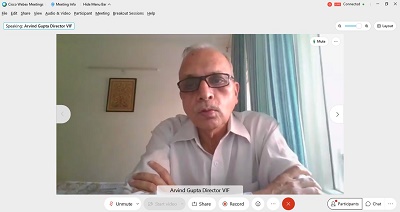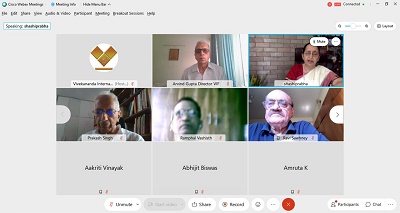Vivekananda International Foundation organised a talk on 31 May 2021 on Introduction to Samkhya and Yoga Philosophy by eminent speaker, Prof. Shashi Prabha Kumar, Dean, Sri Sankaracharya Sanskrit Mahavidyalaya, Bhartiya Vidya Bhavan. This lecture is a part of the VIF lecture series ‘Philosophy for Beginners’. The webinar began with the opening remarks by Dr. Arvind Gupta, Director, VIF.
Prof. Kumar began the lecture by explaining the nomenclature of Samkhya philosophy. She suggested that the Sankhya theory is a theory of evolution. It is an atheistic school where the need to accept God is not felt, said Prof. Kumar. She added that Maharishi Kapil was the propounder of Samkhya philosophy. Samkhya is a dualist, realist and relative school, said Prof Kumar. She said that it’s an orthodox school as it accepts the centrality and authority of Vedas. The two basic entities of Samkhya are Purusha and Prakriti, said Prof. Kumar. She noted that Purusha is the conscious principle, and Prakriti is the material principle behind existence. Moving forward, Prof. Kumar said that Samkhya begins with three sufferings: physical, internal and external. She suggested that there are twenty-five entities in Samkhya. Prof. Kumar added that the twenty-five entities are categorised under four heads: cause (Prakriti), cause and effect (Prakriti and Vikriti), effect (Vikriti), and self (Purusha). Furthermore, she elucidated some theories of Samkhya philosophy, including the theory of causation.
The term yoga is derived from the Sanskrit root yugeryogi, said Prof. Kumar. She said when we combine two entities; it takes the form of yoga. When the individual self is in union with the divine or higher self, it is yoga, said Prof Kumar. She noted that Patanjali is the propagator of yoga which stems back to Rig Veda. She added that Patanjali systematises yoga. Professor Kumar said that yoga is so integral in the Indian system that it is also found in Jainism and Buddhism.

Moving forward, Prof. Kumar suggested that the literature of yoga is extensive; however, yoga sutras are divided into different sections. She added that Vyasa Bhashya is the commentary on yoga sutras. Prof. Kumar said that there are many yoga traditions in India like Patanjali yoga, Rajya yoga, Kriya yoga, Mantra yoga, etc. She elucidated that yoga and Samkhya are not different as someone who has mastered one of them achieves the fruits of both. In addition to that, Prof. Kumar explained that Patanjali defines yoga as restraint or control over self, making it the science of controlling the mind.
Additionally, Prof. Kumar suggested the means to achieve clarity of mind using the path of yoga. She said that four ways of achieving clarity of mind are: friendship with those who are enjoying pleasure (maître), compassion for those who are suffering (karuna), joy towards the virtuous (mudita) and, being neutral to those who are vicious (upeksha). Lastly, Prof Kumar said that the ultimate goal of yoga is “Atma darshan.”

The lecture ended with a question and answer session and closing remarks by Dr Arvind Gupta, Director, VIF.








Post new comment